    
EXCEL COLLEGE of Training & Development
History of Kuala Lumpur

A BRIEF HISTORY
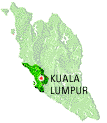 Kuala Lumpur is situated midway along the west coast of Peninsular Malaysia, at the confluence of the Klang and Gombek rivers. It is approximately 35 km from the coast and sits at the centre of the Peninsula's extensive and modern transportation network. Kuala Lumpur is easily the largest city in the nation, possessing a population of over two million people drawn from all of Malaysia's many ethnic groups. Kuala Lumpur is situated midway along the west coast of Peninsular Malaysia, at the confluence of the Klang and Gombek rivers. It is approximately 35 km from the coast and sits at the centre of the Peninsula's extensive and modern transportation network. Kuala Lumpur is easily the largest city in the nation, possessing a population of over two million people drawn from all of Malaysia's many ethnic groups.
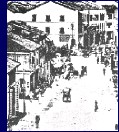 Kuala Lumpur came into existence during the late 1860s when a group of Chinese prospectors in search of the new found metal called "tin" landed at the broad delta focal point of the Gombak and Klang rivers and named the place 'Muddy Convergence' or in the Malay Language 'kuala lumpur'. Although Kuala Lumpur was a tropical diseases infested area, the tin discovered by the early Chinese prospectors in Ampang attracted even more miners and the place named 'Muddy Convergence' quickly became a noisy, brawling, violent boom town in the late 1800s.
Kuala Lumpur came into existence during the late 1860s when a group of Chinese prospectors in search of the new found metal called "tin" landed at the broad delta focal point of the Gombak and Klang rivers and named the place 'Muddy Convergence' or in the Malay Language 'kuala lumpur'. Although Kuala Lumpur was a tropical diseases infested area, the tin discovered by the early Chinese prospectors in Ampang attracted even more miners and the place named 'Muddy Convergence' quickly became a noisy, brawling, violent boom town in the late 1800s.
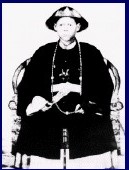 The pioneers were a rough, hardy lot, and the city retains some of that early boom town character. Tin during those years was in huge demand, especially by America and the British Empire, which needed the durable, lightweight metal to help fuel their industrial revolutions. Strategically commanding both river valleys, the community flourished as a tin-collecting centre despite the health challenges it had posed to the tin prospectors. The factions among the early prospectors wrestled for this precious metal and chaos ensued and in 1868, the headmen of the local clans elected a man named Yap Ah Loy as "Kapitan China," or leader of the Chinese community (to handle their community problems) and he became known as the founding father of Kuala Lumpur.
The pioneers were a rough, hardy lot, and the city retains some of that early boom town character. Tin during those years was in huge demand, especially by America and the British Empire, which needed the durable, lightweight metal to help fuel their industrial revolutions. Strategically commanding both river valleys, the community flourished as a tin-collecting centre despite the health challenges it had posed to the tin prospectors. The factions among the early prospectors wrestled for this precious metal and chaos ensued and in 1868, the headmen of the local clans elected a man named Yap Ah Loy as "Kapitan China," or leader of the Chinese community (to handle their community problems) and he became known as the founding father of Kuala Lumpur.
 The merchants of the Straits Settlements, concerned that the war would ruin their prosperity, asked Britain to intervene. Britain was initially reluctant to get involved with internal politics, but rumours that the merchants would turn to Germany instead sparked a fear in London that Britain could lose its tin interests in Malaya. London sent in a new territorial governor, Andrew Clarke, to appraise the situation. Clarke gathered the feuding princes aboard his ship off the island of Pangkor, and convinced them to sign a document known as the Pangkor Agreement. The Agreement ended the war, established a new Sultan of Perak, and most significantly – called for the presence of a British Resident 'who must be asked and acted upon on all questions other than those touching Malay religion and custom.'
The merchants of the Straits Settlements, concerned that the war would ruin their prosperity, asked Britain to intervene. Britain was initially reluctant to get involved with internal politics, but rumours that the merchants would turn to Germany instead sparked a fear in London that Britain could lose its tin interests in Malaya. London sent in a new territorial governor, Andrew Clarke, to appraise the situation. Clarke gathered the feuding princes aboard his ship off the island of Pangkor, and convinced them to sign a document known as the Pangkor Agreement. The Agreement ended the war, established a new Sultan of Perak, and most significantly – called for the presence of a British Resident 'who must be asked and acted upon on all questions other than those touching Malay religion and custom.'
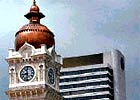 This was the beginning of a dramatically increased British involvement in Malaya, one that would eventually place Kuala Lumpur at centre of history. The British residential system quickly spread. Frank Swettenham, the Resident of Selangor, chose Kuala Lumpur as his administrative centre.
This was the beginning of a dramatically increased British involvement in Malaya, one that would eventually place Kuala Lumpur at centre of history. The British residential system quickly spread. Frank Swettenham, the Resident of Selangor, chose Kuala Lumpur as his administrative centre.
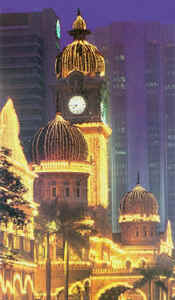
The city became a classic centre of British colonialism. Sharply uniformed officers and bureaucrats administered the FMS from beneath the distinctive copper domes of the Sultan Abdul Samad Building.
 The communist-led guerrilla insurgency began in the first half of the 1900s and threatened the British rule which never succeeded. At midnight on August 30, 1957, amidst a crowd of tens of thousands, British soldiers finally lowered the Union Jack for the last time in front of the Selangor Club. Kuala Lumpur became the capital of the independent Federation of Malaya in 1957 and of Malaysia in 1963.
The communist-led guerrilla insurgency began in the first half of the 1900s and threatened the British rule which never succeeded. At midnight on August 30, 1957, amidst a crowd of tens of thousands, British soldiers finally lowered the Union Jack for the last time in front of the Selangor Club. Kuala Lumpur became the capital of the independent Federation of Malaya in 1957 and of Malaysia in 1963.
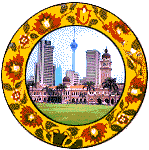
Petronas Twin Towers
The 88-storey PETRONAS Twin Towers, developed as an integral part of the Kuala Lumpur City Centre (KLCC) project, house PETRONAS' new corporate headquarters. The PETRONAS Twin Towers rise like sentinels in the heart of Kuala Lumpur, the capital of Malaysia. Costing a whopping US$1.2bn and uniquely designed by Cesar Pelli & Associates, it rises to 1,483ft (451.9m) in height and is all of 33ft higher than the Sears Tower. Cesar Pelli, former dean of Yale University's School of Architecture, also designed Canary Wharf in London, and the World Financial Center in Manhattan, New York City.
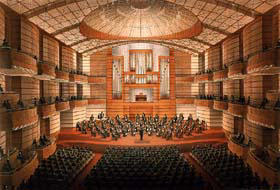
Dewan Filharmonik Petronas
Home to the Malaysian Philharmonic Orchestra
Completed in 1997, the Twin Towers are a striking glass-and-steel combination with floor plans based on an eight-pointed star. The Towers were designed to symbolize strength and grace using geometric principles typified in Islamic architecture. The towers are also joined at the 41st and 42nd floors (175m above street level) by a 192ft-long (58.4m) double-decker skybridge - linking the two sky lobbies and facilitating the movement between the two towers. Inside the 6-storey tower retail podium, music lovers will have access to an 864-seat concert hall (the Dewan Filharmonik Petronas - a venue of architectural and acoustic distinction), an interactive petroleum discovery center (PETROSAINS) will be made ready for science buffs and an art gallery.
The Towers were topped-out in March 1996 and occupation began in early 1997. Tower One is currently being occupied by PETRONAS, the state-owned petroleum corporation. Tower Two is being occupied by PETRONAS' associate companies while the remaining space is being leased out to multinationals.
GRAND OPENING
42nd MERDEKA DAY / INDEPENDENCE DAY
August 31st, 1999
The world's tallest building came alive when it was presented to the world amidst a display of scintillating fireworks and a spectacular light and sound show in an opening ceremony that was filled with pomp and splendor.
Situated in a prime location in the capital, the gleaming 420m Petronas Twin Towers, a symbol of the nation's soaring success, exemplified Malaysia's sky-high ambitions towards the new millennium.
Straining their necks to look upwards, thousands of Malaysians gathered in front of the 88-storey monumental towers as laser beams shone high into the sky to illuminate the country's coming-of-age.
The laminated blue glass paneled windows of the awe-inspiring towers shone as Prime Minister Datuk Seri Dr Mahathir Mohamad officially opened the latest Malaysian physical and economic landmark.
Malaysians from all walks of life witnessed the historic occasion held on the last National Day of the century that symbolized how far the country had come from a country of padi fields and tin mines to one on the verge of industrialization.
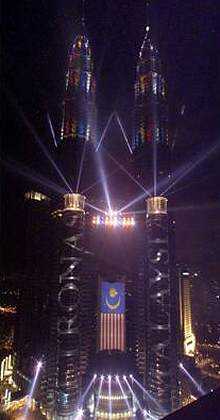 The five-minute light and sound display entitled "A Vision Realized" traced the efforts of the nation in realizing many of the projects that have become the nation's pride.
The five-minute light and sound display entitled "A Vision Realized" traced the efforts of the nation in realizing many of the projects that have become the nation's pride.
The steel and glass architectural marvel that gained international fame through a recent Hollywood movie, "Entrapment", starring Sean Connery and Catherine Zeta-Jones, was also a symbol of the country's ability.
Thousands began lining Jalan Ampang and Jalan P. Ramlee from as early as 7pm.
Following the prime minister's address, a poem entitled "Disisi Menara", written specially for the occasion by poet laureate A. Samad Said was read out by Petronas staff Abdullah Ahmad.
The poem touched on where "a thousand race horses once spurred, forest winds once rustled, now stands sublime the nation's summit, the twin towers, blossoms of the sky."
The Malaysian Philharmonic Orchestra then presented their first ever outdoor performance with patriotic songs.
After the gala of poetry, music and a "tarian lilin" dance by children, Dr Mahathir planted a torch to complete a specially designed light sculpture in a simple display which belied the country's towering goals.
The light sculpture based on an interlocking handshake denoted unity, with three linear fins representing the major races of the country - the Malays, Chinese and Indians.
Dr Mahathir signed the plaque and his signature was beamed into a skybridge screen.
The more than 1,000 foreign and local guests and other Malaysians in the vicinity were then treated to the six-minute light and sound show on the two towers and the sky-screen.
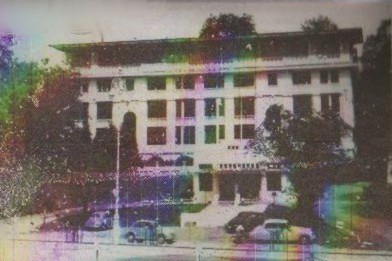
The Majestic Hotel in Kuala Lumpur in 1955 was the place to be.
Expatriates used to live for months in the hotel where dances and tiffin
were a common affair.
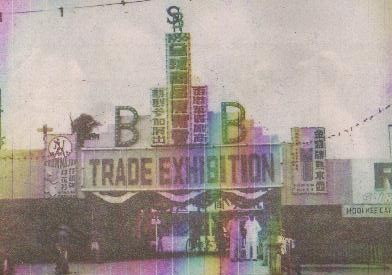
The BB Park trade exhibition before its opening at Bukit Bintang, Kuala Lumpur.
Photo taken in 1955.
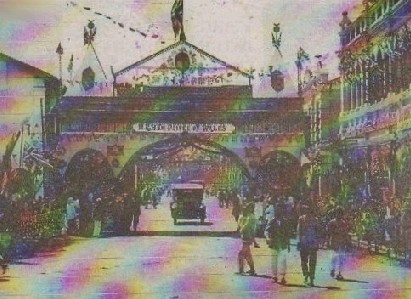
An arch erected across Jalan Raja in Kuala Lumpur to commemorate the
visit of HRH the Prince of Wales, Prince Edward VII.
The photograph was taken either in February or March 1922.
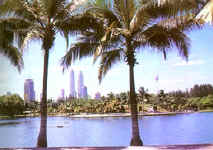
Background of KL today
  
© 2003 Excel College
|